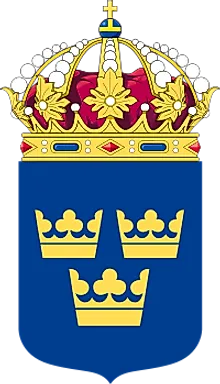Flags, Symbols & Currency of Sweden

The National Flag of Sweden was officially adopted on June 22, 1906.
The National Flag of Sweden features a blue background with a golden yellow Nordic or Scandinavian cross extending to the edges of the flag. The vertical part of the cross is shifted to the hoist side, in the style of the Dannebrog (Danish flag). The Scandinavian cross is symbolic of Christianity. The flag colors reflect those of the Swedish coat of arms - that had three gold crowns on a blue field. The blue color symbolizes loyalty, justice, perseverance, vigilance, and truth. The yellow color symbolizes generosity. The flag has a width-to-length ratio of 5:8.
History of the Flag of Sweden
The exact age of the Swedish Flag is not known, but the oldest recorded pictures of a blue cloth with a yellow cross date from the 16th century. The flag was very popular during the reign of Gustav I Vasa and has been in use since 1521. In 1815, Sweden and Norway were ruled by a single King. To establish this, a “Union mark” was placed in the upper part of both the Swedish and the Norwegian flags. After the Norwegian freedom in 1905, the current form of the Sweden flag was adopted in 1906.
Symbols of Sweden
The National Coat of Arms of Sweden

The National Coat of Arms of Sweden has a greater and a lesser version. The Lesser Coat of Arms is the one more frequently used in Sweden today. This colorful banner features three crowns of gold, two over one, topped by a bejeweled closed royal crown. The three crowns have been, in one way or another, an emblem of Sweden since 1336, then used as a familiar symbol of the "Three Wise Kings." An additional legend regarding its application is that King Magnus Eriksson (1319-64) adopted the three crowns to symbolize his title, "King of Norway, Sweden and all of Scania" - a southern province.
The Greater Coat of Arms represents Sweden's monarch and is used on special occasions by the Government and by the Swedish Parliament. It was developed in the1440s as the seal of the King, Karl Knutsson Bonde, it's been used ever since.
National Motto
"For Sverige i tiden" ("For Sweden – With the Times")
National Anthem
- Anthem Title: "Du gamla, du fria" ("Thou ancient, Thou free")
- Music Composer: Swedish folk song (Arrangement by Edvin Kallstenius)
- Lyricist: Richard Dybeck
- Date of Adoption: 1893 (in use)
"Du gamla, du fria" ("Thou ancient, Thou free") is the national anthem of Sweden. The music of the anthem is based on an old Swedish folk music, which was later arranged by Edvin Kallstenius, a Swedish composer. The lyrics of the anthem have been authored by Richard Dybeck. The Swedish constitution doesn't make any mention of an official national anthem for the country, but Du gamla, Du fria is the widely accepted anthem that is used during ceremonial events. Hence, the national anthem has never been officially legislated and has been in use since 1893.
"Du gamla, du fria"
1.
Du gamla, Du fria, Du fjällhöga nord
Du tysta, Du glädjerika sköna!
Jag hälsar Dig, vänaste land uppå jord,
Din sol, Din himmel, Dina ängder gröna.
Din sol, Din himmel, Dina ängder gröna.
2.
Du tronar på minnen från fornstora dar,
då ärat Ditt namn flög över jorden.
Jag vet att Du är och Du blir vad du var.
Ja, jag vill leva jag vill dö i Norden.
Ja, jag vill leva jag vill dö i Norden.
"Thou ancient, Thou free"
1.
Thou ancient, thou free and mountainous North
Thou quiet, thou joyful beauty!
I greet thee, most beautiful land upon earth,
Thy sun, Thy sky and meadows green.
Thy sun, Thy sky and meadows green.
2.
Thou rest upon memories of great olden days,
When honored thy name flew across the world,
I know that thou art and will be as thou were,
Yes, I want to live I want to die in the North
Yes, I want to live I want to die in the North
The Currency of Sweden is the Swedish krona
The current official currency of Sweden is the Swedish krona (kr, SEK). It has been used as the country’s official currency since 1873. The krona is subdivided into 100 öre. The term ‘krona’ means crown in English. The Central Bank of Sweden is the Sveriges Riksbank, and it is the oldest central bank in the world, having been founded in 1668. Sweden has kept its currency, the Swedish krona after the Swedish residents rejected the adoption of the euro in a referendum.
Coins
Currently, coins in denominations of 5 and 10 kronor and 1 Krona are in circulation.
Banknotes
Currently, banknotes in denominations of 20, 50, 100, 200, 500, and 1,000 kronor are in circulation.
Historical currencies of Sweden
The Scandinavian Monetary Union, which is comprised of Sweden, Denmark, and Norway, had used the gold standard to value the respective currencies of the countries. The Swedish krona was set at 1/2,480 of a kilogram of gold. After WWI, the Monetary union ended in 1914. The gold standard was abandoned on August 2, 1914, but the currencies of the different countries were kept. Sweden kept its krona. The Central Bank of Sweden allowed for the trading of the krona against other world currencies in 1992 and continues to intervene to maintain the value of the krona.












